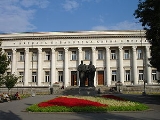
SS. Cyril and Methodius National Library
Encyclopedia
The SS. Cyril and Methodius National Library (Национална библиотека „Свети Свети Кирил и Методий“) is the national library
of Bulgaria
, situated in the capital city of Sofia
. Founded on 4 April 1878, the library received the status of Bulgarian National Library three years later and the Bulgarian National Revival
Archive was merged into it in 1924.
National library
A national library is a library specifically established by the government of a country to serve as the preeminent repository of information for that country. Unlike public libraries, these rarely allow citizens to borrow books...
of Bulgaria
Bulgaria
Bulgaria , officially the Republic of Bulgaria , is a parliamentary democracy within a unitary constitutional republic in Southeast Europe. The country borders Romania to the north, Serbia and Macedonia to the west, Greece and Turkey to the south, as well as the Black Sea to the east...
, situated in the capital city of Sofia
Sofia
Sofia is the capital and largest city of Bulgaria and the 12th largest city in the European Union with a population of 1.27 million people. It is located in western Bulgaria, at the foot of Mount Vitosha and approximately at the centre of the Balkan Peninsula.Prehistoric settlements were excavated...
. Founded on 4 April 1878, the library received the status of Bulgarian National Library three years later and the Bulgarian National Revival
Bulgarian National Revival
The Bulgarian National Revival , sometimes called the Bulgarian Renaissance, was a period of socio-economic development and national integration among Bulgarian people under Ottoman rule...
Archive was merged into it in 1924.
Notable collections
- Slavonic Scriptures, a collection of more than 1,500 originals dating from the 11th to the 19th centuries.
- Greek and other Foreign Scriptures with around 200 monuments, 9th to 19th century.
- Eastern Scriptures, containing around 3,100 ArabicArabic languageArabic is a name applied to the descendants of the Classical Arabic language of the 6th century AD, used most prominently in the Quran, the Islamic Holy Book...
, 500 OttomanOttoman EmpireThe Ottoman EmpireIt was usually referred to as the "Ottoman Empire", the "Turkish Empire", the "Ottoman Caliphate" or more commonly "Turkey" by its contemporaries...
, and 150 PersianPersian languagePersian is an Iranian language within the Indo-Iranian branch of the Indo-European languages. It is primarily spoken in Iran, Afghanistan, Tajikistan and countries which historically came under Persian influence...
codicies, dated 11th to the 19th centuries. - Various archives of Ottoman, Arabic, and Persian documents, catalogued under the Collection of Oriental Archives and the Newer Turkish Archives and 328 separate funds, each sorted by geographical criteria, covering a period from the 15th until the first quarter of the 20th century. Both collections contain over 500,000 units, 714 registers (defters) and 168 sidjals.
- Old Print, Rares and Valuables, a collection of about 30,000 volumes in Old Church SlavonicOld Church SlavonicOld Church Slavonic or Old Church Slavic was the first literary Slavic language, first developed by the 9th century Byzantine Greek missionaries Saints Cyril and Methodius who were credited with standardizing the language and using it for translating the Bible and other Ancient Greek...
, BulgarianBulgarian languageBulgarian is an Indo-European language, a member of the Slavic linguistic group.Bulgarian, along with the closely related Macedonian language, demonstrates several linguistic characteristics that set it apart from all other Slavic languages such as the elimination of case declension, the...
and foreign languages, covering a period from the 15th until the 20th century, plus a collection of Bulgarian Renaissance press from the period before 1878. - Old Print Books from the Orient, a collection of around 2,000 volumes in Arabic, TurkishTurkish languageTurkish is a language spoken as a native language by over 83 million people worldwide, making it the most commonly spoken of the Turkic languages. Its speakers are located predominantly in Turkey and Northern Cyprus with smaller groups in Iraq, Greece, Bulgaria, the Republic of Macedonia, Kosovo,...
and Persian, covering a period from 1593 to the first quarter of the 20th century. - Bulgarian Historical ArchiveBulgarian Historical ArchiveThe Bulgarian Historical Archive functions as part of the SS. Cyril and Methodius National Library and keeps more than 1.5 million documents and a separate collection "Portraits and Photos" consisting of 80,000 photos all of historical importance for Bulgaria and the Balkans.- History :The archive...
with over 1.5 million documents under 700 separate archives covering the work of Bulgarian revolutionaires, economic, cultural and public people from the 18th until the beginning of the 20th century, as well as the history of the independence struggle in MacedoniaMacedonia (region)Macedonia is a geographical and historical region of the Balkan peninsula in southeastern Europe. Its boundaries have changed considerably over time, but nowadays the region is considered to include parts of five Balkan countries: Greece, the Republic of Macedonia, Bulgaria, Albania, Serbia, as...
and Eastern ThraceThraceThrace is a historical and geographic area in southeast Europe. As a geographical concept, Thrace designates a region bounded by the Balkan Mountains on the north, Rhodope Mountains and the Aegean Sea on the south, and by the Black Sea and the Sea of Marmara on the east...
(see History of BulgariaHistory of BulgariaThe history of Bulgaria spans from the first settlements on the lands of modern Bulgaria to its formation as a nation-state and includes the history of the Bulgarian people and their origin. The first traces of human presence on what is today Bulgaria date from 44,000 BC...
). - Portraits and Photographs, a collection of over 80,000 photographs and illustrations.

